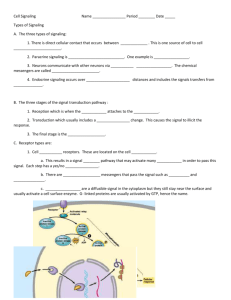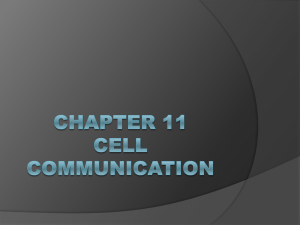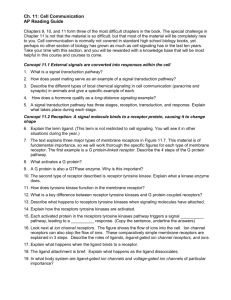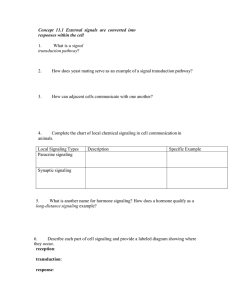AP Biology- Ch 11 Unit: Cell Communication Name: : DATE
advertisement
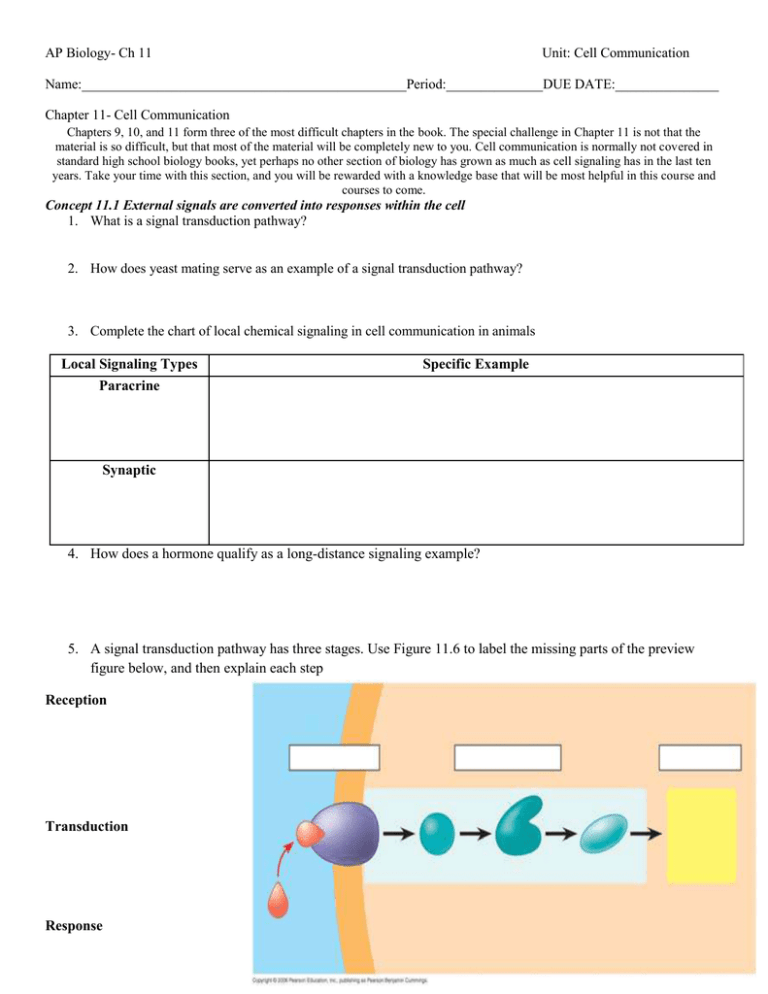
AP Biology- Ch 11 Unit: Cell Communication Name:_______________________________________________Period:______________DUE DATE:_______________ Chapter 11- Cell Communication Chapters 9, 10, and 11 form three of the most difficult chapters in the book. The special challenge in Chapter 11 is not that the material is so difficult, but that most of the material will be completely new to you. Cell communication is normally not covered in standard high school biology books, yet perhaps no other section of biology has grown as much as cell signaling has in the last ten years. Take your time with this section, and you will be rewarded with a knowledge base that will be most helpful in this course and courses to come. Concept 11.1 External signals are converted into responses within the cell 1. What is a signal transduction pathway? 2. How does yeast mating serve as an example of a signal transduction pathway? 3. Complete the chart of local chemical signaling in cell communication in animals Local Signaling Types Specific Example Paracrine Synaptic 4. How does a hormone qualify as a long-distance signaling example? 5. A signal transduction pathway has three stages. Use Figure 11.6 to label the missing parts of the preview figure below, and then explain each step Reception Transduction Response Concept 11.2 Reception: A signal molecule binds to a receptor protein, causing it to change shape 6. Explain the term ligand. (This term is not restricted to cell signaling. You will see it in other situations during the year.) 7. The text will explain three major types of membrane receptors in Figure 11.7. This material is of fundamental importance, so we will work thorough the specific figures for each type of membrane receptor. The first example is a G protein-linked receptor. In the first figure, label the components and then describe the role of the three components. 8. Label and then describe what happens in step 2. 9. Label then describe what happens in step 3. (The yellow box at the bottom right is important!) 10. Equally important to starting a signal is stopping a signal. Step 4 stops the signal. (Failure to do so can lead to serious problems, like cancer.) Label and then describe how the signal is halted. 11. What activates a G protein? 12. A G protein is also a GTPase enzyme. Why is this important? 13. The second type of receptor described is receptor tyrosine kinase. Explain what a kinase enzyme does. 14. How does tyrosine kinase function in the membrane receptor? 15. What is a key difference between receptor tyrosine kinases and G protein-coupled receptors? 16. Provide all of the missing labels on the diagram; then explain what happens in step 1. 17. Label step 2 and then describe what happens to receptors tyrosine kinases when signaling molecules have attached. 18. Label and explain how the receptors are activated in step 3. 19. Use step 4 to explain how the activated receptor can stimulate multiple cellular response pathways. 20. Each activated protein in the figure above triggers a signal _________________ pathway leading to a ______________ response. 21. Moving to ion channel receptors, the example in Figure 11.7 shows the flow of ions into the cell. Ion channel receptors can also stop the flow of ions. These comparatively simple membrane receptors are explained in three steps. In the first step, label the diagram and then explain the role of the labeled molecules. 22. Label the diagram and then explain what has happened with the binding of the ligand to the receptor. 23. The ligand attachment to the receptor is brief. Label and explain what happens as the ligand dissociates. 24. In what body system are ligand-gated ion channels and voltage-gated ion channels of particular importance? 25. Intracellular receptors are found in the __________ or ____________ of the cell, where they bond to chemical messengers that are ________________ or very small, like nitric oxide. 26. This diagram uses testosterone, a hydrophobic hormone, to detail how intracellular receptors work. At each arrow, add an explanation of what is happening in the cell. 27. An important idea, transcription factors, is introduced in Figure11.8. Explain the function of transcription factors in the cell. Concept 11.3 Transduction: Cascades of molecular interactions relay signals from receptors to target molecules in the cell 28. What are two benefits of multistep pathways like the one in Figure 11.9? 29. Explain the role of these two categories of enzymes in transduction. Protein kinase Protein phosphatases 30. Using Figure 11.9 as your guide, explain what is occurring in the cell at each arrow. 31. What is the difference between a first messenger and a second messenger? 32. Two common second messengers are cyclic AMP (cAMP) and calcium ions (Ca2+). Explain the role of the second messenger cAMP in Figure 11.11 from the text. 33. What is the important relationship between the second messenger and protein kinase A? 34. Figure 11.11 explains how to initiate a cellular response; how might that response be inhibited? 35. Using your new knowledge of cell signaling, explain the mechanism of disease in cholera. 36. List three types of pathways often induced by calcium ions. 37. What happens to the cytoplasmic concentration of calcium when it is used as a second messenger? Concept 11.4 Response: Cell signaling leads to regulation of transcription or cytoplasmic activities 38. When cell signaling causes a response in the nucleus, what normally happens? 39. When cell signaling causes a response in the cytoplasm, what normally happens? 40. Figure 11.15 shows a single molecule of epinephrine resulting in the formation of __________ molecules of glucose-1-phosphate! 41. Figure 11.17 shows four different cellular results from a single signaling molecule. Briefly describe each response. Cell A Cell B Cell C Cell D 42. How do scaffolding proteins enhance a cellular response? Concept 11.5 Apoptosis (programmed cell death) integrates multiple cell-signaling pathways 43. What specifically happens to a cell during the process of apoptosis? 44. The signal for apoptosis can come from outside or inside the cell. Give one example when the signal comes from outside the cell and two examples of cellular occurrences that would prompt an apoptosis signal from inside the cell.



